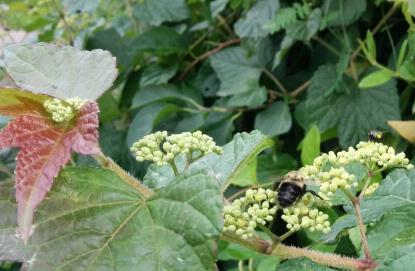
I don’t think it’s still there, but a few years ago I complimented the bakers at the Hungry Ghost on a vine growing just outside their door. The berries were in various state of ripeness going from green through yellow to purple and blue. The plant had climbed up much of the front of the building and had glossy green leaves, providing a striking site. I went home and found that it’s called porcelain berry or Ampelopsis brevipedunculata. I also discovered that it’s made itself a pest as it spreads rapidly in this country, creating dense mats that kill off other plants – even trees. Making matters worse, birds love the berries so spread the seeds all over the place.
I saw one in flower the other day. Though I couldn’t smell anything and the flowers looked essentially non-descript, it was covered in pollinators. There were your standard honeybee sized bees, flies, a golden digger wasp and lots of others moving too quickly for me to identify. What was particularly nice was that nobody in the area seemed to notice: no one screaming that they might be stung. This despite the plant’s location right next to a mini-golf tourist trap.
This invasive plant is providing food for pollinators who desperately need it. Eventually it will also provide food for birds. Even an invasive alien can have its good sides. If it could make mini-golf go away I would forgive it its other trespasses.
One of porcelain berry’s striking traits is the way the berries change color. Most fruits have an unripe color, often green, that slowly changes to the ripe color. Tomatoes, peppers, blueberries, raspberries and apples all do this. Porcelain berry plants sport fruit clusters with four or five colors at once: turquoise, pale yellow, lilac, dark blue and green.
What causes this is the interaction of several chemicals from two families of pigments anthocyanins and flavonols (Yoshitama et al Journal of Plant Physiology, 1992). These are the usual suspects in terms of fruit color, but what is unusual here are the number of different colors. Apparently what happens is the pH of the liquid in the berry changes from quite acidic to near neutral as the berry ripens. pH is a measure of the concentration of hydrogen ions in solution. The number is –log10 of the concentration of hydrogen, for those keeping track. The scale goes from acidic (1) to basic (14) with 7 as a nice happy neutral point, and the lower number meaning more hydrogen. What’s a bit quirky about the scale is that going down one actually means 10 times more acidic. So something that is pH 5 has ten times as much hydrogen in solution as something that’s pH 6.
The porcelain berry fruits start out at pH 4.8 when they’re green. That’s about the pH of a good ale or a soda. It is also nearly ten times more acidic than the point, pH 5.5, which erodes your tooth enamel. As the berries ripen the pH goes up to pH 6.5; which is about the pH of milk. The pigments absorb light differently as the pH changes and this causes the berries’ color to change.
I haven’t tasted them, but normally the low pH would give the berries a sour flavor, this would disappear as the pH went up. Unfortunately, according to all the typical edible plant websites, they are slimy. This doesn’t seem to bother the birds. This plant fits nicely into the ecosystem in a few ways: pollinators and birds love it. If something would develop a voracious appetite for the leaves it might become less invasive. It is a relative of grapes, perhaps we could sell it for dolmas.


